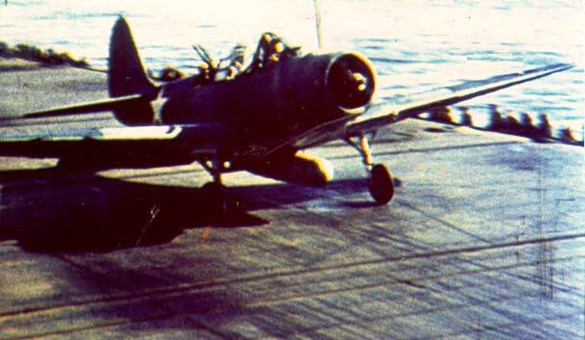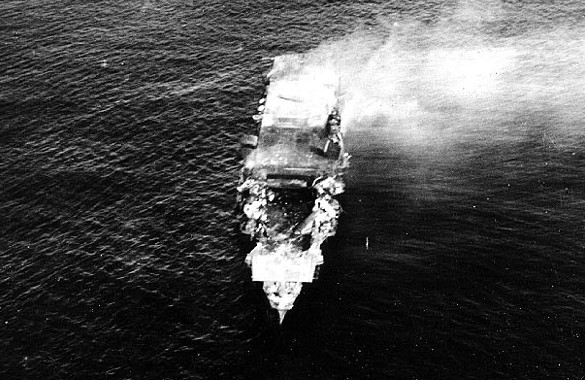June 04, 2009
What If #3: Midway... Timing Is Everything
In the previous post, reader Toad asks:
If the American torpedo and dive bombers had managed to make a coordinated attack per doctrine how much difference would it have made if any on the number of Japanese carriers sunk and damaged?
It would, indeed, make a difference, but perhaps not the way you may be expecting.
As in life, love, baseball and comedy, the Battle of Midway is all about timing. Disrupt the timing of the American attacks, and you disrupt the outcome. Throughout the morning of June 4th, 1942, American planes ran in on Kido Butai. At no time during the day, until the famous plunge of the Dauntlesses, were these attacks coordinated or in greater than squadron strength. Also at no time during the day, until the big attack, were American fighters effectively on the scene (there were Wildcats on the scene when VT-6 made its run, but they were high above the fight waiting for a radio call on a different frequency from a different squadron).
The easiest way to describe the effect of all these seperate attacks had on the Japanese fleet is to borrow a phrase from land combat: suppressive fire. The carriers were too busy "keeping their heads down" and tossing the occasional grenade (or Zeros, in the case) at their attackers from behind cover to launch their own attack on the US carriers.
The sequence of events went like this:
Shortly before 6am, the Japanese carriers were spotted by Midway-based PBYs.
*Around 620am, the Japanese strike on Midway Island began.
*At 7am, TF16 (Enterprise, Hornet) began launching their strike against the Japanese.
*Between 705am and 730am, the VT-8 detachment flying from Midway and a handful of B-26s carrying topedoes attack the Japanese carriers. During this time, Admiral Nagumo, commander of Kido Butai, orders that his reserve force of carrier planes be rearmed for land attack.
*Around 745am, Tone #4, the infamous late scout plane, discovers and reports the presence of American carriers. Nagumo reverses his rearming order.
*At 755am, two unrelated attacks on the Japanese carriers come in. First, a flight of B-17s arrive overhead. At the same time, a green squadron of Dauntless dive bombers from Midway, led by Major Lofton Henderson, begin a glide bombing attack. This attack is dealt with sternly, and is over by 815am or so.
*At 8am, TF17 (Yorktown), which had been in charge of scouting for the morning, launches its planes.
*At 805am, the Midway strike planes return to Kido Butai and wait for the American attacks to be driven off.
*Around 820am, a second group of dive bombers from Midway, this time SB2U Vindicators, attacks and is beaten off.
*Around 835am, the SB2U and B-17 attacks come to an end.
*Immediately thereafter, recovery of the Midway strike force begins.
*Around 910am, the last planes from the strike force touch down.
*At 915am, VT-8 attacks. By 935am, all of the torpedo bombers are shot down.
*At 940am, VT-6 attacks. This attack is over by 1010am.
*At 1010am, VT-3 is spotted.
*At 1020am, VB-3 and VB-6 attack Kido Butai.
*By 1030am, the Soryu, Kaga and Akagi are mortally wounded.
*Around 1040am, VT-3's survivors make their torpedo attacks and leave the field.
From this timeline, it can be seen that the Japanese carriers had no time to even prepare to launch an attack on the American CVs. The only open stretch available to them was between 835am and 910am, the time when the Midway strike force was being recovered. They could have spotted and launched an attack during this stretch of time (even though the re-rearming of the reserve planes wasn't yet complete), but only at the risk of losing many of the Midway strike planes to fuel depravation or pilot injuries. Japanese doctrine at the time did not allow for, say, Hiryu and Kaga to launch an attack while Soryu and Akagi recovered planes. Doctrine called for massed airpower using large numbers of planes in a balanced, coordinated attack. This would swamp the target's defenses and allow for maximum damage to be inflicted while minimizing casualties. There was never any thought to leaving the Midway strike dangling, because that's not how the Japanese carriers worked.
So, what would have happened if a coordinated American strike had been launched and all the attackers arrived on target at the same time?
The answer, as mentioned before, comes down to timing.
more...
If the American torpedo and dive bombers had managed to make a coordinated attack per doctrine how much difference would it have made if any on the number of Japanese carriers sunk and damaged?
It would, indeed, make a difference, but perhaps not the way you may be expecting.
As in life, love, baseball and comedy, the Battle of Midway is all about timing. Disrupt the timing of the American attacks, and you disrupt the outcome. Throughout the morning of June 4th, 1942, American planes ran in on Kido Butai. At no time during the day, until the famous plunge of the Dauntlesses, were these attacks coordinated or in greater than squadron strength. Also at no time during the day, until the big attack, were American fighters effectively on the scene (there were Wildcats on the scene when VT-6 made its run, but they were high above the fight waiting for a radio call on a different frequency from a different squadron).
The easiest way to describe the effect of all these seperate attacks had on the Japanese fleet is to borrow a phrase from land combat: suppressive fire. The carriers were too busy "keeping their heads down" and tossing the occasional grenade (or Zeros, in the case) at their attackers from behind cover to launch their own attack on the US carriers.
The sequence of events went like this:
Shortly before 6am, the Japanese carriers were spotted by Midway-based PBYs.
*Around 620am, the Japanese strike on Midway Island began.
*At 7am, TF16 (Enterprise, Hornet) began launching their strike against the Japanese.
*Between 705am and 730am, the VT-8 detachment flying from Midway and a handful of B-26s carrying topedoes attack the Japanese carriers. During this time, Admiral Nagumo, commander of Kido Butai, orders that his reserve force of carrier planes be rearmed for land attack.
*Around 745am, Tone #4, the infamous late scout plane, discovers and reports the presence of American carriers. Nagumo reverses his rearming order.
*At 755am, two unrelated attacks on the Japanese carriers come in. First, a flight of B-17s arrive overhead. At the same time, a green squadron of Dauntless dive bombers from Midway, led by Major Lofton Henderson, begin a glide bombing attack. This attack is dealt with sternly, and is over by 815am or so.
*At 8am, TF17 (Yorktown), which had been in charge of scouting for the morning, launches its planes.
*At 805am, the Midway strike planes return to Kido Butai and wait for the American attacks to be driven off.
*Around 820am, a second group of dive bombers from Midway, this time SB2U Vindicators, attacks and is beaten off.
*Around 835am, the SB2U and B-17 attacks come to an end.
*Immediately thereafter, recovery of the Midway strike force begins.
*Around 910am, the last planes from the strike force touch down.
*At 915am, VT-8 attacks. By 935am, all of the torpedo bombers are shot down.
*At 940am, VT-6 attacks. This attack is over by 1010am.
*At 1010am, VT-3 is spotted.
*At 1020am, VB-3 and VB-6 attack Kido Butai.
*By 1030am, the Soryu, Kaga and Akagi are mortally wounded.
*Around 1040am, VT-3's survivors make their torpedo attacks and leave the field.
From this timeline, it can be seen that the Japanese carriers had no time to even prepare to launch an attack on the American CVs. The only open stretch available to them was between 835am and 910am, the time when the Midway strike force was being recovered. They could have spotted and launched an attack during this stretch of time (even though the re-rearming of the reserve planes wasn't yet complete), but only at the risk of losing many of the Midway strike planes to fuel depravation or pilot injuries. Japanese doctrine at the time did not allow for, say, Hiryu and Kaga to launch an attack while Soryu and Akagi recovered planes. Doctrine called for massed airpower using large numbers of planes in a balanced, coordinated attack. This would swamp the target's defenses and allow for maximum damage to be inflicted while minimizing casualties. There was never any thought to leaving the Midway strike dangling, because that's not how the Japanese carriers worked.
So, what would have happened if a coordinated American strike had been launched and all the attackers arrived on target at the same time?
The answer, as mentioned before, comes down to timing.
more...
Posted by: Wonderduck at
10:44 PM
| Comments (3)
| Add Comment
Post contains 1570 words, total size 12 kb.
A Miraculous Day, A Tragic Day
June 4th, 1942.

Midway Island.

John Waldron, Commander of Torpedo 8, takes off from USS Hornet around 7am.

Waldron's Torpedo 8 attacked the Japanese fleet at 920am. By 940am, all of the men in this picture save for Ensign George Gay (circled) were dead.
Their loss, along with the savaging of Torpedo 6 off the Enterprise and Torpedo 3 from the Yorktown, a total of 36 out of 41 TBD Devastators launched, prevented the four carriers of the Japanese force from launching their own airstrike. Then the Dauntless dive bombers of the fleet arrived... and the rest is history.

Japanese carrier Hiryu, pummled by multiple bomb hits, burns later in the day. She would sink shortly after this picture was taken.
The USN did not escape unscathed, however. The Yorktown, hastily repaired after the Coral Sea, took multiple hits and went dead in the water.

On June 7th, after being torpedoed by a submarine, she went down.

The Battle of Midway, that "miraculous victory", was over.
The Japanese would not win another strategic victory for the rest of the war.

Midway Island.

John Waldron, Commander of Torpedo 8, takes off from USS Hornet around 7am.

Waldron's Torpedo 8 attacked the Japanese fleet at 920am. By 940am, all of the men in this picture save for Ensign George Gay (circled) were dead.
Their loss, along with the savaging of Torpedo 6 off the Enterprise and Torpedo 3 from the Yorktown, a total of 36 out of 41 TBD Devastators launched, prevented the four carriers of the Japanese force from launching their own airstrike. Then the Dauntless dive bombers of the fleet arrived... and the rest is history.

Japanese carrier Hiryu, pummled by multiple bomb hits, burns later in the day. She would sink shortly after this picture was taken.
The USN did not escape unscathed, however. The Yorktown, hastily repaired after the Coral Sea, took multiple hits and went dead in the water.

On June 7th, after being torpedoed by a submarine, she went down.

The Battle of Midway, that "miraculous victory", was over.
The Japanese would not win another strategic victory for the rest of the war.
Posted by: Wonderduck at
08:53 AM
| Comments (5)
| Add Comment
Post contains 186 words, total size 2 kb.
<< Page 1 of 1 >>
30kb generated in CPU 0.0242, elapsed 0.1883 seconds.
46 queries taking 0.1786 seconds, 169 records returned.
Powered by Minx 1.1.6c-pink.
46 queries taking 0.1786 seconds, 169 records returned.
Powered by Minx 1.1.6c-pink.









